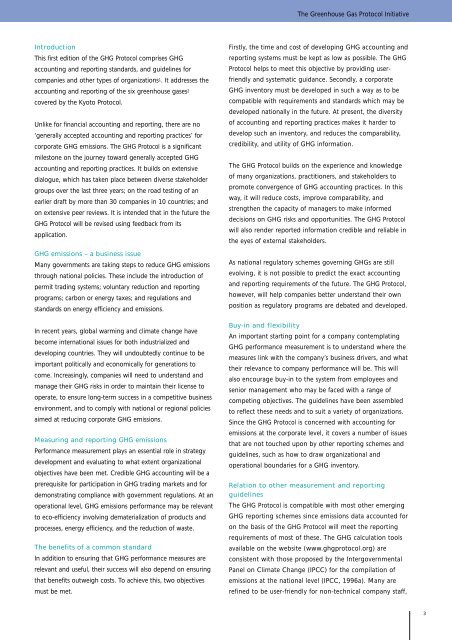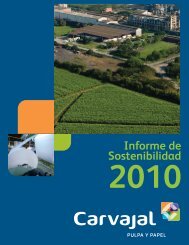Descarge el documento aquà - Cecodes
Descarge el documento aquà - Cecodes
Descarge el documento aquà - Cecodes
Create successful ePaper yourself
Turn your PDF publications into a flip-book with our unique Google optimized e-Paper software.
The Greenhouse Gas Protocol InitiativeIntroductionThis first edition of the GHG Protocol comprises GHGaccounting and reporting standards, and guid<strong>el</strong>ines forcompanies and other types of organizations 1 . It addresses theaccounting and reporting of the six greenhouse gases 2covered by the Kyoto Protocol.Unlike for financial accounting and reporting, there are no‘generally accepted accounting and reporting practices’ forcorporate GHG emissions. The GHG Protocol is a significantmilestone on the journey toward generally accepted GHGaccounting and reporting practices. It builds on extensivedialogue, which has taken place between diverse stakeholdergroups over the last three years; on the road testing of anearlier draft by more than 30 companies in 10 countries; andon extensive peer reviews. It is intended that in the future theGHG Protocol will be revised using feedback from itsapplication.GHG emissions – a business issueMany governments are taking steps to reduce GHG emissionsthrough national policies. These include the introduction ofpermit trading systems; voluntary reduction and reportingprograms; carbon or energy taxes; and regulations andstandards on energy efficiency and emissions.In recent years, global warming and climate change havebecome international issues for both industrialized anddev<strong>el</strong>oping countries. They will undoubtedly continue to beimportant politically and economically for generations tocome. Increasingly, companies will need to understand andmanage their GHG risks in order to maintain their license tooperate, to ensure long-term success in a competitive businessenvironment, and to comply with national or regional policiesaimed at reducing corporate GHG emissions.Measuring and reporting GHG emissionsPerformance measurement plays an essential role in strategydev<strong>el</strong>opment and evaluating to what extent organizationalobjectives have been met. Credible GHG accounting will be aprerequisite for participation in GHG trading markets and fordemonstrating compliance with government regulations. At anoperational lev<strong>el</strong>, GHG emissions performance may be r<strong>el</strong>evantto eco-efficiency involving dematerialization of products andprocesses, energy efficiency, and the reduction of waste.The benefits of a common standardIn addition to ensuring that GHG performance measures arer<strong>el</strong>evant and useful, their success will also depend on ensuringthat benefits outweigh costs. To achieve this, two objectivesmust be met.Firstly, the time and cost of dev<strong>el</strong>oping GHG accounting andreporting systems must be kept as low as possible. The GHGProtocol h<strong>el</strong>ps to meet this objective by providing userfriendlyand systematic guidance. Secondly, a corporateGHG inventory must be dev<strong>el</strong>oped in such a way as to becompatible with requirements and standards which may bedev<strong>el</strong>oped nationally in the future. At present, the diversityof accounting and reporting practices makes it harder todev<strong>el</strong>op such an inventory, and reduces the comparability,credibility, and utility of GHG information.The GHG Protocol builds on the experience and knowledgeof many organizations, practitioners, and stakeholders topromote convergence of GHG accounting practices. In thisway, it will reduce costs, improve comparability, andstrengthen the capacity of managers to make informeddecisions on GHG risks and opportunities. The GHG Protocolwill also render reported information credible and r<strong>el</strong>iable inthe eyes of external stakeholders.As national regulatory schemes governing GHGs are stillevolving, it is not possible to predict the exact accountingand reporting requirements of the future. The GHG Protocol,however, will h<strong>el</strong>p companies better understand their ownposition as regulatory programs are debated and dev<strong>el</strong>oped.Buy-in and flexibilityAn important starting point for a company contemplatingGHG performance measurement is to understand where themeasures link with the company’s business drivers, and whattheir r<strong>el</strong>evance to company performance will be. This willalso encourage buy-in to the system from employees andsenior management who may be faced with a range ofcompeting objectives. The guid<strong>el</strong>ines have been assembledto reflect these needs and to suit a variety of organizations.Since the GHG Protocol is concerned with accounting foremissions at the corporate lev<strong>el</strong>, it covers a number of issuesthat are not touched upon by other reporting schemes andguid<strong>el</strong>ines, such as how to draw organizational andoperational boundaries for a GHG inventory.R<strong>el</strong>ation to other measurement and reportingguid<strong>el</strong>inesThe GHG Protocol is compatible with most other emergingGHG reporting schemes since emissions data accounted foron the basis of the GHG Protocol will meet the reportingrequirements of most of these. The GHG calculation toolsavailable on the website (www.ghgprotocol.org) areconsistent with those proposed by the IntergovernmentalPan<strong>el</strong> on Climate Change (IPCC) for the compilation ofemissions at the national lev<strong>el</strong> (IPCC, 1996a). Many arerefined to be user-friendly for non-technical company staff,3
















